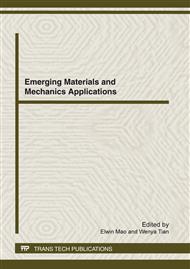[1]
Zhang Liwen, Zhu Daxi, Wang Mingwei, Heat transfer coefficient of quenching medium research , J. Metal heat treatment. 2008, 33(1): 53-56.
Google Scholar
[2]
Cheng Heming, Huang Xieqing, Xie jianbin. Comparison of surface heat-transfer coefficients between warious diameter cylinders during rapid cooling [J]. Journal of Materials Processing Technology, 2003, 138: 398-403.
DOI: 10.1016/s0924-0136(03)00106-7
Google Scholar
[3]
Price R F and Fletcher A J. Determination of heat transfer coefficients during quenching of steel plates [J]. Metal Technology, 1980, 11(6): 202~211.
DOI: 10.1179/030716980803286739
Google Scholar
[4]
Zhang Zhengrong, Heat transfer, M. People's Education Press, Beijing, pp.56-58.
Google Scholar
[5]
BUNKER C E,HARRUFF B A, PATHAK P,et al.Formation of cadmium sulfide nanoparticles in reverse micelles:Extreme sensitivity to preparation procedure[J].Langmuir,2005,20(13):5642-5644.
DOI: 10.1021/la049607+
Google Scholar
[6]
Gur C H,Tekkaya A E,Schuler W.Effect of boundary conditions and work piece geometry on residual stresses and microstructure in quenching process[J].Steel Research,1996,67(11):501-506.
DOI: 10.1002/srin.199605527
Google Scholar
[7]
WILLIAMD. Using on-line predictive computer modeling to optimize heat treats processing [J]. Industry Heat, 1996(5): 51.
Google Scholar
[8]
INOUE T, ARIMOTO K. Implementation of program for simulating heat treatment processes and some results [J]. Industry Heat, 1995(4): 41.
Google Scholar
[9]
WILLIAM KAYS/MICHAEL CRAAWFORD/BERNHARD WEIGAND. Convective Heat and Mass Transfer (Fourth Edition).
Google Scholar
[10]
Webb B W, Ramadhyani S. Conjugate heat transfer in a channel with staggered ribs. Int JHeat Mass Transfer, 1986. 29: 1679-1687.
DOI: 10.1016/0017-9310(85)90142-5
Google Scholar


